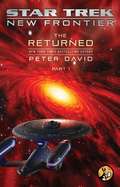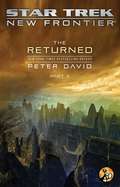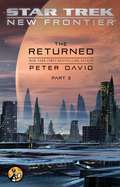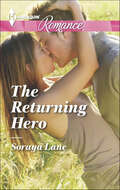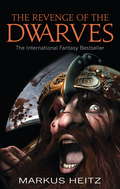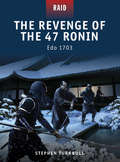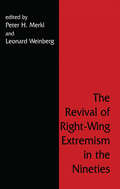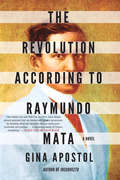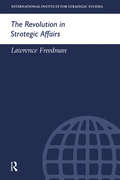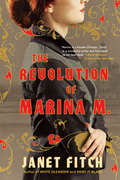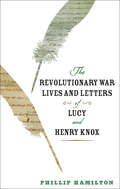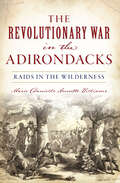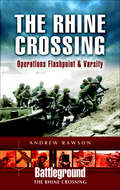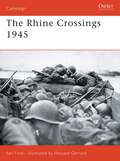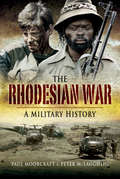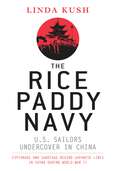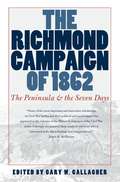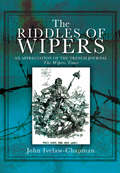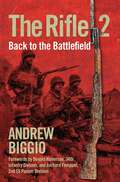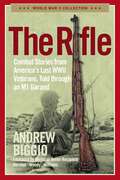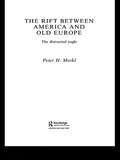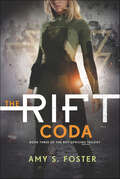- Table View
- List View
The Returned, Part I (Cold Equations)
by Peter DavidThe first installment in a brand-new three-part digital-first Star Trek: New Frontier e-novel from New York Times bestselling author Peter David!<P><P> Captain Mackenzie Calhoun and the crew of the U.S.S. Excalibur are back, picking up three months after the stunning events depicted in New Frontier: Blind Man’s Bluff. Calhoun's search of Xenex has failed to find any survivors, and now he is bound and determined to track down the race that killed them—the D'myurj and their associates, the Brethren—and exact vengeance upon them. His search will take the Excalibur crew into a pocket universe, where he discovers not only the homeworld of the D’myurj, but another race that shares Calhoun's determination to obliterate his opponents. But is this new race truly an ally…or an even greater threat?
The Returned, Part II (Cold Equations)
by Peter DavidThe second installment in a brand-new three-part digital-first Star Trek: New Frontier e-novel from New York Times bestselling author Peter David! Captain Mackenzie Calhoun and the crew of the U.S.S. Excalibur are back, picking up three months after the stunning events depicted in New Frontier: Blind Man’s Bluff. Calhoun's search of Xenex has failed to find any survivors, and now he is bound and determined to track down the race that killed them—the D'myurj and their associates, the Brethren—and exact vengeance upon them. His search will take the Excalibur crew into a pocket universe, where he discovers not only the homeworld of the D’myurj, but another race that shares Calhoun's determination to obliterate his opponents. But is this new race truly an ally…or an even greater threat?
The Returned, Part III (Cold Equations)
by Peter DavidThe final installment in a brand-new three-part digital-first Star Trek: New Frontier e-novel from New York Times bestselling author Peter David! Captain Mackenzie Calhoun and the crew of the U.S.S. Excalibur are back, picking up three months after the stunning events depicted in New Frontier: Blind Man’s Bluff. Calhoun's search of Xenex has failed to find any survivors, and now he is bound and determined to track down the race that killed them—the D'myurj and their associates, the Brethren—and exact vengeance upon them. His search will take the Excalibur crew into a pocket universe, where he discovers not only the homeworld of the D’myurj, but another race that shares Calhoun's determination to obliterate his opponents. But is this new race truly an ally…or an even greater threat?
The Returning Hero (The Soldier's Homecoming)
by Soraya LaneYou can't help who you fall for... Six months after her husband's death, Jamie knows she has to start living again. And when fellow soldier Brett Palmer turns up, Jamie knows it's fate. Brett is the only other person who can make her feel alive again. Brett swore he would protect Jamie, but being so close to her is driving him insane. So Brett does everything he can to fight their connection. Until the words slip out-he's always loved her. With a second chance staring them both in the face, there is no going back....
The Revenge Of The Dwarves: Book 3 (Dwarves #3)
by Markus HeitzLife has not been easy for battle-weary Tungdil the dwarf. But this heroic warrior can't rest yet, as he must now face the most formidable enemy the kingdom has ever encountered.A new evil is terrorising the land of Girdlegard. Monstrous hybrid creatures are on the rampage, leaving a trail of destruction in their wake. They are out to steal an artefact which is vital for the kingdom's defence, and whoever holds it could control the world.With the existence of the dwarves under threat, Tungdil must resort to his trusty double axe and risk everything he knows to save his country from annihilation . . .Hold your breath for THE REVENGE OF THE DWARVES, the next thrilling instalment in this spectacular epic from international bestselling author Markus Heitz.Other books by Markus Heitz:The DwarvesThe War of the DwarvesThe Fate of the DwarvesThe Triumph of the DwarvesRighteous FuryDevastating HateDark PathsRaging StormAera book's one to ten
The Revenge of the 47 Ronin - Edo 1703
by Stephen Turnbull Johnny ShumateFrom 1600 till 1866 civil strife in public was virtually unknown in Japan; however, personal loyalty and self-sacrifice could at times rise above the samurai hierarchy to redefine Japanese culture. In 1703 former samurai avenged their lord in the most legendary raid in Japanese history. The story of the 47 ronin is a tale rich in emotion, precise planning, and flawless martial execution. This was the raid that turned Japan upside down.Lord Kira had brought about the death of Lord Asano, thus making Asano's loyal samurai into ronin (unemployed 'men of the waves'). In complete secrecy they plotted their revenge, and one snowy winter's night launched a raid against his mansion in Edo (Tokyo). The gates were broken down, and after the fiercest sword battle seen in Japan for over a century Kira was captured and beheaded. His head was washed and placed on Asano's tomb. The Shogun had now been placed in a dilemma. Should he reward the 47 Ronin for behaving more like true samurai than anyone since the time of civil wars, or should they be punished for breaking the strict laws about taking revenge?In the end the law prevailed, and the surviving 46 ronin committed a mass act of hara-kiri, turning them overnight into national heroes as the 'gods of bushido'.. The dramatic revenge raid of the Forty-Seven Ronin is the ideal subject for a Raids title. There is a very strong narrative and a wealth of illustrative material. As the raid occurred during the peaceful Edo Period there is scope for original description of the samurai's weapons and their personal & physical environment that is not seen in any other Osprey titles.From the Trade Paperback edition.
The Revival of Right Wing Extremism in the Nineties
by Peter H. Merkl Leonard WeinbergMost studies of the radical right concentrate on movements in a single country, neglecting to some extent the international dimensions of right-wing extremism. Here, Merkl and Weinberg adopt a comparative perspective, concentrating on the revival of the right across a variety of countries.
The Revolution According to Raymundo Mata
by Gina ApostolRevealing glimpses of the Philippine Revolution and the Filipino writer Jose Rizal emerge despite the worst efforts of feuding academics in Apostol&’s hilariously erudite novel, which won the Philippine National Book Award.Gina Apostol&’s riotous second novel takes the form of a memoir by one Raymundo Mata, a half-blind bookworm and revolutionary, tracing his childhood, his education in Manila, his love affairs, and his discovery of writer and fellow revolutionary, Jose Rizal. Mata&’s 19th-century story is complicated by present-day foreword(s), afterword(s), and footnotes from three fiercely quarrelsome and comic voices: a nationalist editor, a neo-Freudian psychoanalyst critic, and a translator, Mimi C. Magsalin. In telling the contested and fragmentary story of Mata, Apostol finds new ways to depict the violence of the Spanish colonial era, and to reimagine the nation&’s great writer, Jose Rizal, who was executed by the Spanish for his revolutionary activities, and is considered by many to be the father of Philippine independence. The Revolution According to Raymundo Mata offers an intoxicating blend of fact and fiction, uncovering lost histories while building dazzling, anarchic modes of narrative.
The Revolution in Strategic Affairs (Adelphi series #318)
by Lawrence FreedmanRapid developments in information technology and precision weaponry are said to herald a 'revolution in military affairs' (RMA), making possible quick and decisive victories with minimal casualties and collateral damage. But has such a revolution taken place? The issues that drive conflict will persist, and many of the technical advances associated with the RMA will not necessarily produce a transformation in the nature of warfare. The end of the Cold War has highlighted another revolution one in political affairs. Major powers appear less likely to go to war with one another than they are to intervene in conflicts involving weak states, with potential opponents including militia groups, drug cartels and terrorists. RMA technology may be less suited to conflicts such as these. If the cumulative effect of these changes has produced a revolution, it is a revolution in strategic, as much as military, affairs. This paper argues that: the RMA is the practical expression of a 'Western Way of Warfare', the key features of which are: professional armed forces; intolerance of casualties; and intolerance of collateral damage the key technological and conceptual components of the RMA were in place by the early 1970s. The trend has therefore been evolutionary, rather than revolutionary. The significant difference is in the new political setting of the end of the Cold War, and the revolution in perceptions of Western particularly US conventional military strength brought about by the Gulf War of 1991 the Gulf conflict could mark the start of a true 'revolution' if future battles offer similar opportunities to exploit the RMA's technology. However, since the US and its allies appear unbeatable when fighting on their own terms, future opponents will fight differently the West will therefore face opponents who will follow strategies that contradict the Western Way of Warfare. They will avoid pitched battles, will exploit the West's reluctance to inflict civilian suffering, and will target their opponent's domestic political base, as much as its forward troops. The problem for the West is not how to prevail, but how to do so in an acceptable manner. The more warfare becomes entwined with civilian activity, the more difficult it is to respond with the type of decisive and overwhelming military means embodied in the RMA. The RMA does not create a situation in which information is the only commodity at stake, and so does not offer the prospect of a 'virtual war'. The new circumstances and capabilities do not prescribe one strategy, but extend the range of strategies available. The issue underlying the RMA is the ability of Western countries, in particular the US, to follow a line geared to their own interests and capabilities.
The Revolution of Marina M.: A Novel (A Novel)
by Janet FitchFrom the mega-bestselling author of White Oleander and Paint It Black, a sweeping historical saga of the Russian Revolution, as seen through the eyes of one young womanOne of Entertainment Weekly's Most Buzzworthy Books of Fall 2017St. Petersburg, New Year's Eve, 1916. Marina Makarova is a young woman of privilege who aches to break free of the constraints of her genteel life, a life about to be violently upended by the vast forces of history. Swept up on these tides, Marina will join the marches for workers' rights, fall in love with a radical young poet, and betray everything she holds dear, before being betrayed in turn.As her country goes through almost unimaginable upheaval, Marina's own coming-of-age unfolds, marked by deep passion and devastating loss, and the private heroism of an ordinary woman living through extraordinary times. This is the epic, mesmerizing story of one indomitable woman's journey through some of the most dramatic events of the last century.
The Revolutionary War Lives and Letters of Lucy and Henry Knox
by Phillip HamiltonLove and marriage during the Revolutionary War through the letters of Lucy and Henry Knox.In 1774, Boston bookseller Henry Knox married Lucy Waldo Flucker, the daughter of a prominent Tory family. Although Lucy’s father was the third-ranking colonial official in Massachusetts, the couple joined the American cause after the Battles of Lexington and Concord and fled British-occupied Boston. Knox became a soldier in the Continental Army, where he served until the war’s end as Washington’s artillery commander.While Henry is well known to historians, his private life and marriage to Lucy remain largely unexplored. Phillip Hamilton tells the fascinating story of the Knoxes’ relationship amid the upheavals of war. Like John and Abigail Adams, the Knoxes were often separated by the revolution and spent much of their time writing to one another. They penned nearly 200 letters during the conflict, more than half of which are reproduced and annotated for this volume.This correspondence—one of the few collections of letters between revolutionary-era spouses that spans the entire war—provides a remarkable window into the couple’s marriage. Placed at the center of great events, struggling to cope with a momentous conflict, and attempting to preserve their marriage and family, the Knoxes wrote to each other in a direct and accessible manner as they negotiated shifts in gender and power relations. Working together, Henry and Lucy maintained their household and protected their property, raised and educated their children, and emotionally adjusted to other dramatic changes within their family, including a total break between Lucy and her Tory family. Combining original epistles with Hamilton’s introductory essays, The Revolutionary War Lives and Letters of Lucy and Henry Knox offers important insights into how this relatable and highly individual couple overcame the war’s challenges.
The Revolutionary War Lives and Letters of Lucy and Henry Knox
by Phillip Hamilton“[This] collection of Lucy and Henry Knox’s correspondence movingly reveals a marriage and a nation coming of age in the crucible of the Revolutionary War.” —Lorri Glover, author of Eliza Lucas PinckneyIn 1774, Boston bookseller Henry Knox married Lucy Waldo Flucker, the daughter of a prominent Tory family. Although Lucy’s father was the third-ranking colonial official in Massachusetts, the couple joined the American cause after the Battles of Lexington and Concord and fled British-occupied Boston. Knox became a soldier in the Continental Army, where he served until the war’s end as Washington’s artillery commander.Their correspondence—one of the few collections of letters between revolutionary-era spouses that spans the entire war—provides a remarkable window into the couple’s marriage. Placed at the center of great events, struggling to cope with a momentous conflict, and attempting to preserve their marriage and family, the Knoxes wrote to each other in a direct and accessible manner as they negotiated shifts in gender and power relations. Working together, Henry and Lucy maintained their household and protected their property, raised and educated their children, and emotionally adjusted to other dramatic changes within their family, including a total break between Lucy and her Tory family. Combining original epistles with Hamilton’s introductory essays, The Revolutionary War Lives and Letters of Lucy and Henry Knox offers important insights into how this relatable and highly individual couple overcame the war’s challenges.“A fascinating and important addition to the literature of marriage and family life during the revolution. These unique letters, punctuated by excellent narrative interludes, provide a rich vein of information about the war.” —Edith B. Gelles, author of Abigail and John: Portrait of a Marriage
The Revolutionary War in the Adirondacks: Raids in the Wilderness
by Marie Danielle WilliamsThis lively history of the American Revolution explores the combat that took place in the Adirondack Mountains of New York. Much of New York during the Revolutionary era was frontier wilderness, sparsely populated and bitterly divided. Although the only major campaign in the region would end at the Battle of Saratoga, factional raiding parties traversed the mountains and valleys of the Adirondacks throughout the war. Sir Christopher Carleton led groups of Loyalists, Hessians and Iroquois in successful attacks along Lake Champlain, capturing forts and striking fear in local villages. Mohawk war chief Joseph Brant led a motley band of irregulars known as &“Brant&’s Volunteers&” in chaotic raids against Patriot targets. Marauding brothers Edward and Ebenezer Jessup brought suffering to the very lands they had purchased years before in Kingsbury, Queensbury and Fort Edward. In this volume, historian Marie Danielle Annette Williams chronicles these and other stories of the Revolutionary War in the Adirondacks.
The Rhine Crossing: Operations Flashpoint & Varsity (Battleground The Rhine Crossing)
by Andrew RawsonA detailed account of &“the last great set piece operation carried out by the western Allies during the Second World War . . . surprisingly comprehensive.&”—Pegasus Archive By Spring 1945, with the Russians closing fast on Berlin from the East, the US and British Armies of Patton and Montgomery were faced with one major hurdle, the Rhine. Heavily defended by the Nazis, this obstacle would only be crossed by a massive operation requiring meticulous planning and bold execution. The resulting operation involving 29 divisions was outstandingly successful. This book follows the river crossings by 30th and 79th US Divisions, codenamed Operation FLASHPOINT and the airdrop by 17th US Airborne Division (VARSITY). While covering quite different sectors, this book can be read in conjunction with its sister volumes Operation Varsity and Operation Plunder by Tim Saunders.
The Rhine Crossings 1945
by Howard Gerrard Ken Ford'The last great heave of war,' according to Churchill, took place with the crossing of the Rhine in 1945. No invading army had crossed this great river since Napoleon's in 1805, and the task fell to Field Marshal Montgomery's 21st Army Group. Opposing them were the forces of a failing fascist regime, including battalions of old men and boys, strengthened by several formations of crack troops, including paratroopers and Panzer Grenadiers.This book details the devastating Anglo-American assault from Arnhem, starting with the battle of Arnhem, and leading on to the successful crossing of the Rhine and eventual breakout, and continuing with the advance across northern Germany. Including comprehensive details on all aspects of the operation, including the amphibious assault, airborne landings, special forces' attack and armored land battle, this book charts the history of the last great set-piece battle of the war, second in magnitude only to the Normandy invasion, that ultimately brought the defeat of Hitler's Nazi regime one step closer.From the Trade Paperback edition.
The Rhodesian War: A Military History (Stackpole Military History Ser.)
by Paul Moorcraft Peter McLaughlinA military history of the former British colony of Southern Rhodesia—now Zimbabwe—spanning from 1890 to the 1970s. In this exciting book, authors Paul Moorcroft and Peter McLaughlin examine the military history of Southern Rhodesia, from the first resistance to colonial rule through the period of UDI by the Smith government to the Lancaster House agreement that transferred power. They recount the Rhodesian security forces&’ operations against the Black nationalist guerillas, and the intensity of the fighting and courage of the participants will surprise and enthrall readers. Atrocities were committed by both sides, but equally the protagonists were playing for very high stakes. But this is more than just a book on military operations. The authors provide expert analysis of the historical situation and examine events up to the present day, including Mugabe&’s operations against rival tribes and white farmers. For a thorough work on its subject, this book cannot be bettered. It is essential reading for those wishing to learn more about a counter-insurgency campaign. The ingenuity of the Rhodesian military fighting against overwhelming odds and restricted by sanctions is impressive, but the outcome culminating in the Lancaster House Agreement was inevitable.Praise for The Rhodesian War&“An outstanding exception to most accounts of the Rhodesian civil war . . . achieved impressive objectivity in concentrating on operational issues.&” —Anthony Verrier, author of The Road to Zimbabwe&“The book is full of intrigue and plots. South African intelligence wanted to assassinate Mugabe, but there might also have been plans afoot to kill of Britain&’s Prince Charles during his visit to Harare.&” —Heidi Kingstone, The Star (South Africa)
The Rice Paddy Navy
by Linda KushAfter the Japanese attack on Pearl Harbor, the U.S. Navy knew it would need vital information from the Pacific. Nationalist China was particularly well-suited to provide vital information about the Japanese and the Pacific weather patterns. Captain Milton 'Mary' Miles journeyed to China to set up weather stations and monitor the Chinese coastline--and to spy on the Japanese. After a meeting and a handshake agreement with Chiang Kai-shek's spymaster, General Dai Li, the Sino-American Cooperative Organization was born. SACO consisted of nearly 3,000 American servicemen (from the Navy, Marines, and Army), 97,000 organized Chinese guerrillas, and 20,000 "individualists," including rival pirate groups and lone-wolf saboteurs. This top-secret network worked hand in hand with the Nationalist Chinese to fight the Japanese occupation of China while it erected crucial weather stations, intercepted and cracked Japanese code, blew up enemy supply depots, laid mines, destroyed bridges, sank scores of vessels, and trained Chinese peasants in guerrilla warfare. Its work supplied critical information to the U.S. military, rescued more than seventy-five downed aviators, and contributed to the felling of more than 26,000 Japanese--while losing only five of their own men. SACO--"the rice paddy navy"--was one of the best-kept secrets of the war. Miles and his SACO men battled military attacks, harsh conditions, dangerous weather, and political in-fighting to provide unprecedented intelligence and training that helped further the Allies' cause in the Pacific. Working at times in tandem and at odds with the OSS, SACO helped build bridges between the Americans and the Chinese in a fight for the security of Asia. In The Rice Paddy Navy, Linda Kush reveals the story of this covert operation, uncovering the military accomplishments, diplomatic ties, and political wrangling that colored one of the most successful--and little known-- efforts of World War II.From the Hardcover edition.
The Richmond Campaign of 1862
by Gary W. GallagherThe Richmond campaign of April-July 1862 ranks as one of the most important military operations of the first years of the American Civil War. Key political, diplomatic, social, and military issues were at stake as Robert E. Lee and George B. McClellan faced off on the peninsula between the York and James Rivers. The climactic clash came on June 26-July 1 in what became known as the Seven Days battles, when Lee, newly appointed as commander of the Confederate forces, aggressively attacked the Union army. Casualties for the entire campaign exceeded 50,000, more than 35,000 of whom fell during the Seven Days. This book offers nine essays in which well-known Civil War historians explore questions regarding high command, strategy and tactics, the effects of the fighting upon politics and society both North and South, and the ways in which emancipation figured in the campaign. The authors have consulted previously untapped manuscript sources and reinterpreted more familiar evidence, sometimes focusing closely on the fighting around Richmond and sometimes looking more broadly at the background and consequences of the campaign.Contributors:William A. BlairKeith S. BohannonPeter S. CarmichaelGary W. GallagherJohn T. HubbellR. E. L. KrickRobert K. KrickJames MartenWilliam J. MillerThe Richmond campaign of 1862, waged by armies under Robert E. Lee and George B. McClellan, ranks as one of the most important military operations of the first years of the American Civil War. This book offers nine essays in which well-known Civil War historians explore questions regarding high command, strategy and tactics, the effects of the fighting upon politics and society both North and South, and the ways in which emancipation figured in the campaign. The authors have consulted previously untapped manuscript sources and reinterpreted more familiar evidence, sometimes focusing closely on the fighting around Richmond and sometimes looking more broadly at the background and consequences of the campaign. The contributors are William A. Blair, Keith S. Bohannon, Peter S. Carmichael, Gary W. Gallagher, John T. Hubbell, Robert E. L. Krick, Robert K. Krick, James Marten, and William J. Miller.-->
The Richmond Raid
by John BrickMajor Hank Stephens was forced to leave West Point in 1860 when he married a girl who told him she was pregnant by him. After the war began, Kate Farnham married a fellow West Point man who left to fight for the Confederacy. She began an affair with Stephens, which lasted throughout the war. Kilpatrick, an overly ambitious man, takes the command away from Stephens just before the raid begins, and the disaster that results affects the lives of all concerned. Sergeant Terlie, whose wife badly wants a child to help fill the aching void left by the deaths of her children by her first marriage, rides away on the raid the day after she learns that, once again, she isn't pregnant. Johnny Watkins is helped by a Rebel girl after he is seriously wounded, and must decide whether to honor his promise to her and her father, a deserter from the rebel army. Hank Stephens, tired and bitter about the mismanagement of the campaign, is captured and confined in prison, where he is confronted by Royce Farnham, Kate's husband. Royce has previously sustained a serious injury, but is working on General Bragg's staff. However, Kate comes to Richmond to be near Hank, and nurses her husband who has serious complications from his wound.
The Riddles Of Wipers: An Appreciation of the Trench Journal "The Wipers Times"
by John Ivelaw-ChapmanThe Wipers Times was the Private Eye of the Ypres Salient during World War One. Edited, while under bombardment, by a battalion commander in the Sherwood Foresters, written by soldiers actually in the trenches and distributed by ration-wagon and ammunition-mule. the paper bears vivid witness to the shocking realities of trench warfare. Yet for all the occasional horror of its content, The Wipers Times was a gentle, humor-filled and satirical paper which, once its codes are cracked and its riddles solved, tells an interested reader much about the characters and personalities of the men in the British Army of the First World War.Interpretation of regular features such as the bogus music-hall advertisements that feature in every issue, columns like Answers to our Many Correspondents and Things We Want to Know and careful study of some of the remarkable poetry published in the paper, explain to readers what it was like to be there. The Mud, the Gas, the Shells; the Fear, the Courage, the Humour and the Bitterness; much is revealed about these and many other things in this remarkable book that unravels the eighty-year-old Riddles of Wipers.
The Rifle 2: Back to the Battlefield
by Andrew BiggioIn this highly anticipated follow-up to The Rifle, Andrew Biggio brings to light more untold stories from the quickly vanishing ranks of the veterans of World War II.Biggio&’s discovery of the astonishing effect his 1945 M1 Garand rifle had on the old warriors who held it sparked a unique personal mission to put it in the hands of as many veterans as possible and document the wartime memories it evoked. In this second volume, he recounts more unforgettable stories from the last of the soldiers, sailors, airmen, and Marines who fought the most dreadful war in history. They were the Greatest Generation, but they were also ordinary men, sharing in all of humanity&’s weaknesses and flaws while trying to respond to the call of duty. That rifle brought out some dark and painful secrets. These stories form a unique record of the heights and depths which the human spirit reaches in war.
The Rifle: Combat Stories from America's Last WWII Veterans, Told Through an M1 Garand
by Andrew BiggioIt all started because of a rifle. The Rifle is an inspirational story and hero&’s journey of a 28-year-old U.S. Marine, Andrew Biggio, who returned home from combat in Afghanistan and Iraq, full of questions about the price of war. He found answers from those who survived the costliest war of all -- WWII veterans. It began when Biggio bought a 1945 M1 Garand Rifle, the most common rifle used in WWII, to honor his great uncle, a U.S. Army soldier who died on the hills of the Italian countryside. When Biggio showed the gun to his neighbor, WWII veteran Corporal Joseph Drago, it unlocked memories Drago had kept unspoken for 50 years. On the spur of the moment, Biggio asked Drago to sign the rifle. Thus began this Marine&’s mission to find as many WWII veterans as he could, get their signatures on the rifle, and document their stories. For two years, Biggio traveled across the country to interview America&’s last-living WWII veterans. Each time he put the M1 Garand Rifle in their hands, their eyes lit up with memories triggered by holding the weapon that had been with them every step of the war. With each visit and every story told to Biggio, the veterans signed their names to the rifle. 96 signatures now cover that rifle, each a reminder of the price of war and the courage of our soldiers.
The Rift Between America and Old Europe: The Distracted Eagle (Contemporary Security Studies)
by Peter MerklThis new book explains the recent rift between America and some of her oldest European allies, especially with Germany and France. Particular attention is devoted to the several competing interpretations of the Euro-American rift, for example, that Europeans were taken aback when American neo-conservative leaders scornfully rejected their well-meant offers of post-9/11 assistance with expressions of disdain for the allies' backward military technology and budgets. The Bush administration's rejection of the Kyoto Treaty, its environmental stance and its position on international treaties are also examined in detail. Merkl's interpretation emphasizes America's neo-imperial, unilateralist posture and policies as contrasted to the Wilsonian internationalism that created the United Nations and established international rule of law backed up by the Security Council, a web of international treaties and international courts, including the International Court of Criminal Justice. Today's American leaders thus oppose European champions of an American-initiated international order while identifying themselves with the imperialist European doctrines and practices of another age.
The Rift Coda: The Rift Uprising Trilogy, Book 3 (The Rift Uprising Trilogy #3)
by Amy S. FosterA young supersoldier assembles an improbable army to defeat a dangerous enemy in this action-packed finale of a science fiction adventure trilogy.Ryn Whittaker started an uprising. Now she must end it.Not long ago, Ryn knew what her future would be—as a Citadel, a genetically enhanced super-soldier, it was her job to protect her version of Earth among an infinite number of other versions in the vast Multiverse at any cost. But when Ezra Massad arrived on Ryn’s Earth, her life changed in an instant, and he pushed her to start asking why she was turned into a Citadel in the first place.What began as merely an investigation into her origins ended up hurling Ryn, Ezra, and Ryn’s teammate Levi through the Multiverse and headlong into a conspiracy so vast and complex that Ryn can no longer merely be a soldier . . . she must now be a general. And in becoming a true leader, she must forge alliances with unpredictable species, make impossible decisions, and face deep sacrifices. She must lead not thousands, but hundreds of thousands of troops under her command and in doing so, leave any trace of her childhood behind.Ryn always knew that she was created to fight. But now she must step forward and lead.
